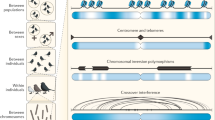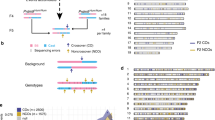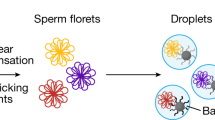Abstract
Human meiotic crossovers mainly cluster into narrow hot spots1 that profoundly influence patterns of haplotype diversity2 and that may also affect genome instability3 and sequence evolution4,5,6. Hot spots also seem to be ephemeral7,8,9, but processes of hot-spot activation and their subsequent evolutionary dynamics remain unknown. We now analyze the life cycle of a recombination hot spot. Sperm typing revealed a polymorphic hot spot that was activated in cis by a single base change, providing evidence for a primary sequence determinant necessary, though not sufficient, to activate recombination. This activating mutation occurred roughly 70,000 y ago and has persisted to the present, most likely fortuitously through genetic drift despite its systematic elimination by biased gene conversion. Nonetheless, this self-destructive conversion will eventually lead to hot-spot extinction. These findings define a subclass of highly transient hot spots and highlight the importance of understanding hot-spot turnover and how it influences haplotype diversity.
This is a preview of subscription content, access via your institution
Access options
Subscribe to this journal
Receive 12 print issues and online access
$209.00 per year
only $17.42 per issue
Buy this article
- Purchase on Springer Link
- Instant access to full article PDF
Prices may be subject to local taxes which are calculated during checkout




Similar content being viewed by others
References
McVean, G.A. et al. The fine-scale structure of recombination rate variation in the human genome. Science 304, 581–584 (2004).
Jeffreys, A.J., Kauppi, L. & Neumann, R. Intensely punctate meiotic recombination in the class II region of the major histocompatibility complex. Nat. Genet. 29, 217–222 (2001).
Lindsay, S.J., Khajavi, M., Lupski, J.R. & Hurles, M.E. A chromosomal rearrangement hotspot can be identified from population genetic variation and is coincident with a hotspot for allelic recombination. Am. J. Hum. Genet. 79, 890–902 (2006).
Spencer, C.C.A. et al. The influence of recombination on human genetic diversity. PLoS Genet. 2, e148 (2006).
Dreszer, T.R., Wall, G.D., Haussler, D. & Pollard, K.S. Biased clustered substitutions in the human genome: the footprints of male-driven biased gene conversion. Genome Res. 17, 1420–1430 (2007).
Duret, L. & Arndt, P.F. The impact of recombination on nucleotide substitutions in the human genome. PLoS Genet. 4, e1000071 (2008).
Ptak, S.E. et al. Fine-scale recombination patterns differ between chimpanzees and humans. Nat. Genet. 37, 429–434 (2005).
Winckler, W. et al. Comparison of fine-scale recombination rates in humans and chimpanzees. Science 308, 107–111 (2005).
Jeffreys, A.J., Neumann, R., Panayi, M., Myers, S. & Donnelly, P. Human recombination hot spots hidden in regions of strong marker association. Nat. Genet. 37, 601–606 (2005).
Webb, A.J., Berg, I.L. & Jeffreys, A. Sperm cross-over activity in regions of the human genome showing extreme breakdown of marker association. Proc. Natl. Acad. Sci. USA 105, 10471–10476 (2008).
Coop, G., Wen, X., Ober, C., Pritchard, J.K. & Przeworski, M. High-resolution mapping of crossovers reveals extensive variation in fine-scale recombination patterns among humans. Science 319, 1395–1398 (2008).
The International HapMap Consortium. A second generation human haplotype map of over 3.1 million SNPs. Nature 449, 851–861 (2007).
Maniatis, N. et al. The first linkage disequilibrium (LD) maps: delineation of hot and cold blocks by diplotype analysis. Proc. Natl. Acad. Sci. USA 99, 2228–2233 (2002).
Jeffreys, A.J. & Neumann, R. Reciprocal crossover asymmetry and meiotic drive in a human recombination hot spot. Nat. Genet. 31, 267–271 (2002).
Jeffreys, A.J. & Neumann, R. Factors influencing recombination frequency and distribution in a human meiotic crossover hotspot. Hum. Mol. Genet. 14, 2277–2287 (2005).
Jeffreys, A.J. & May, C.A. Intense and highly localized gene conversion activity in human meiotic crossover hot spots. Nat. Genet. 36, 151–156 (2004).
Myers, S., Freeman, C., Auton, A., Donnelly, P. & McVean, G. A common sequence motif associated with recombination hot spots and genome instability in humans. Nat. Genet. 40, 1124–1129 (2008).
Neumann, R. & Jeffreys, A.J. Polymorphism in the activity of human crossover hotspots independent of local DNA sequence variation. Hum. Mol. Genet. 15, 1401–1411 (2006).
Peters, A.D. A combination of cis and trans control can solve the hotspot conversion paradox. Genetics 178, 1579–1593 (2008).
Coop, G. & Myers, S.R. Live hot, die young: transmission distortion in recombination hotspots. PLoS Genet. 3, e35 (2007).
Pineda-Krch, M. & Redfield, R.J. Persistence and loss of meiotic recombination hotspots. Genetics 169, 2319–2333 (2005).
Boulton, A., Myers, R.S. & Redfield, R.J. The hotspot conversion paradox and the evolution of meiotic recombination. Proc. Natl. Acad. Sci. USA 94, 8058–8063 (1997).
Jeffreys, A.J., Murray, J. & Neumann, R. High-resolution mapping of crossovers in human sperm defines a minisatellite-associated recombination hotspot. Mol. Cell 2, 267–273 (1998).
Jeffreys, A.J., Ritchie, A. & Neumann, R. High resolution analysis of haplotype diversity and meiotic crossover in the human TAP2 recombination hotspot. Hum. Mol. Genet. 9, 725–733 (2000).
Hudson, R.R. & Kaplan, N.L. Statistical properties of the number of recombination events in the history of a sample of DNA sequences. Genetics 111, 147–164 (1985).
Arndt, P.F., Hwa, T. & Petrov, D.A. Substantial regional variation in substitution rates in the human genome: importance of GC content, gene density, and telomere-specific effects. J. Mol. Evol. 60, 748–763 (2005).
Thomson, R., Pritchard, J.K., Shen, P., Oefner, P.J. & Feldman, M.W. Recent common ancestry of human Y chromosomes: evidence from DNA sequence data. Proc. Natl. Acad. Sci. USA 97, 7360–7365 (2000).
Hudson, R.R. The variance of coalescent time estimates from DNA sequences. J. Mol. Evol. 64, 702–705 (2007).
Morton, N.E. Outline of Genetic Epidemiology (Karger, Basel, Switzerland, 1982).
Acknowledgements
We thank J. Blower and volunteers for providing semen samples, T.E. King and P. Balaresque for DNA samples, A. Webb for bioinformatics support, colleagues for helpful discussions, and the Medical Research Council, the Wellcome Trust (ref. 081227/Z/06/Z), the Royal Society and the Louis-Jeantet Foundation for funding support.
Author information
Authors and Affiliations
Contributions
A.J.J. and R.N. designed the study and performed the analyses, and A.J.J. wrote the paper.
Corresponding author
Supplementary information
Supplementary Text and Figures
Supplementary Methods and Supplementary Figures 1 and 2 (PDF 1435 kb)
Rights and permissions
About this article
Cite this article
Jeffreys, A., Neumann, R. The rise and fall of a human recombination hot spot. Nat Genet 41, 625–629 (2009). https://doi.org/10.1038/ng.346
Received:
Accepted:
Published:
Issue Date:
DOI: https://doi.org/10.1038/ng.346
This article is cited by
-
Reconstructing past changes in locus-specific recombination rates
BMC Genetics (2013)
-
Meiotic recombination in mammals: localization and regulation
Nature Reviews Genetics (2013)
-
Recombination rate variation in closely related species
Heredity (2011)
-
Variation in crossover rates across a 3-Mb contig of bread wheat (Triticum aestivum) reveals the presence of a meiotic recombination hotspot
Chromosoma (2011)
-
Mammalian recombination hot spots: properties, control and evolution
Nature Reviews Genetics (2010)



